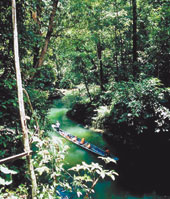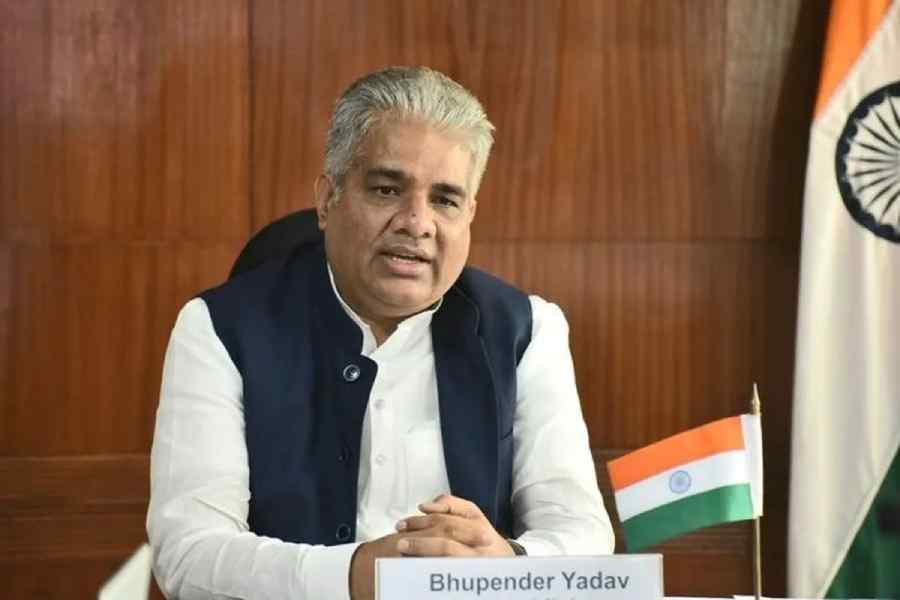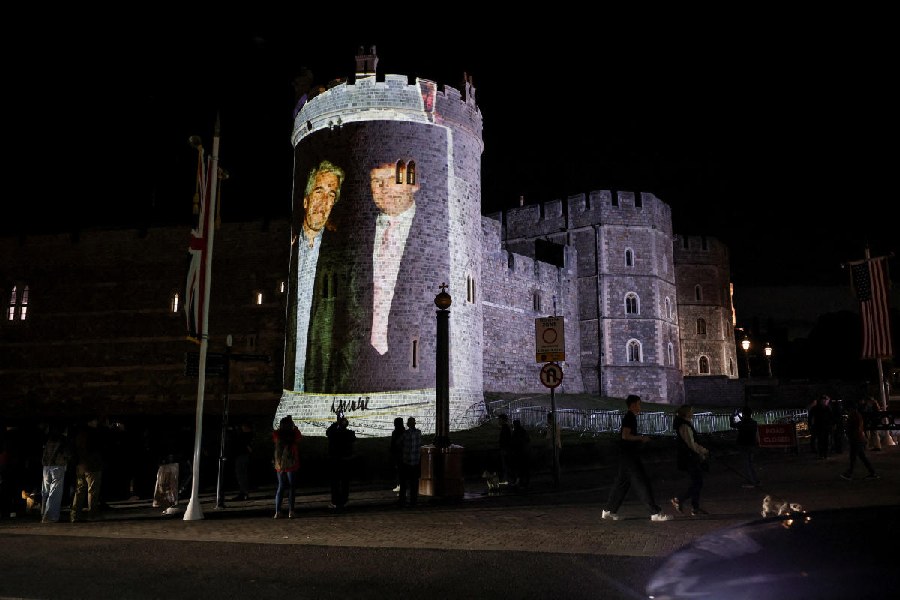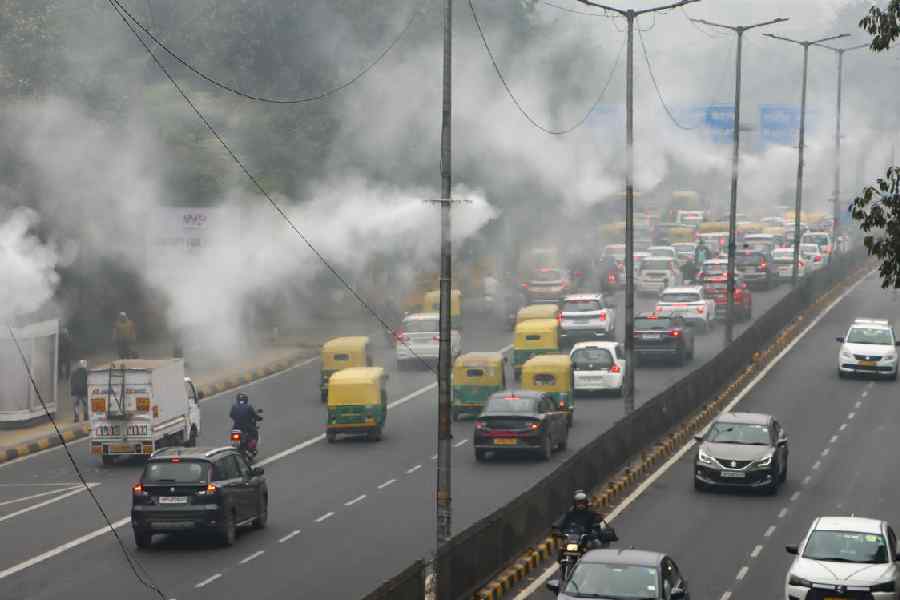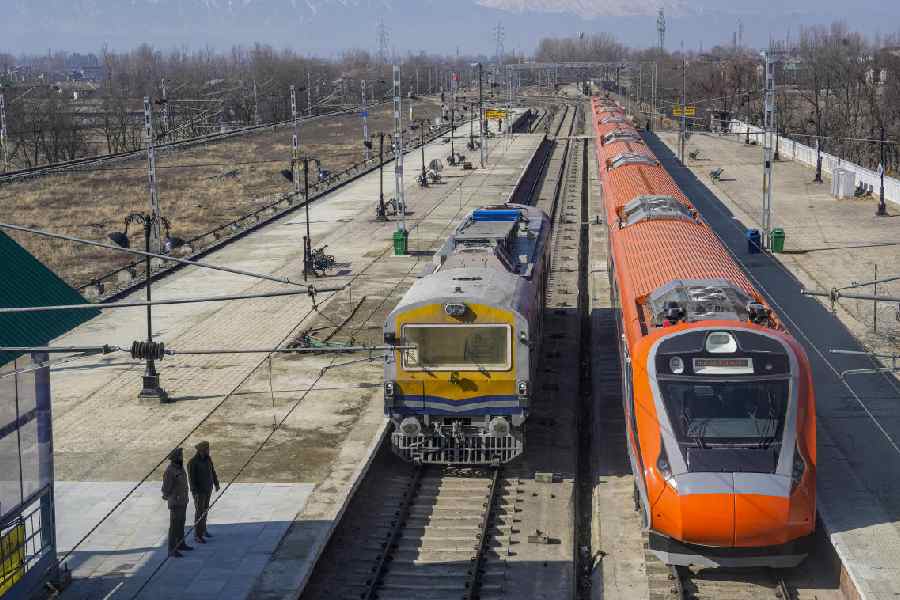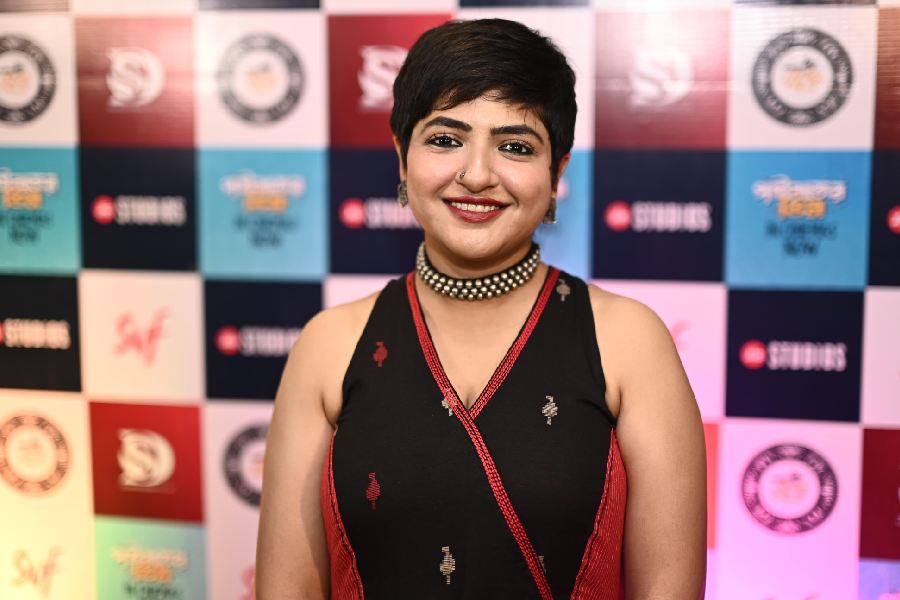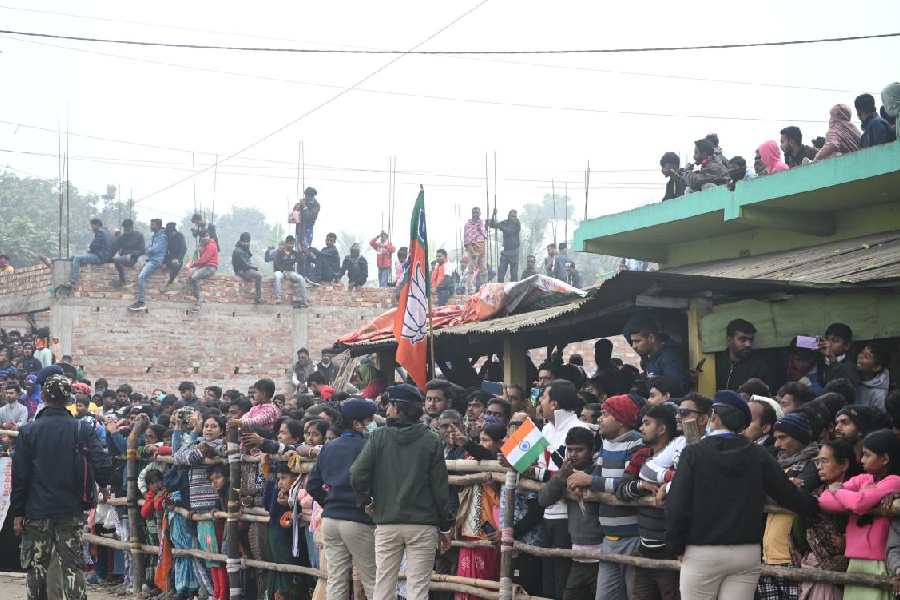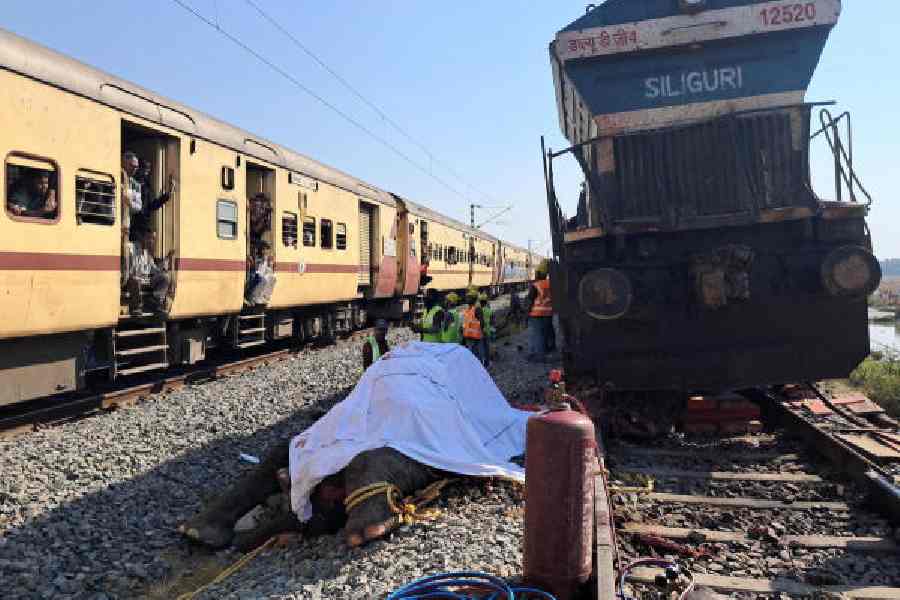 |
 |
 |
 |
| (From top): a boat makes its way up the Batang Ai river; feline sculptures at Kuching; a view of the Batang Ai lake, a baby orangutan peers out through a cage |
Headhunters, orang-utans and lush green tropical rain forests. Throw in a hotel surrounded by a lake and a river with the mountains in the background. What more could one ask for?
The holiday (a honeymoon actually) began when we rose into the sky from Kuala Lumpur?s magnificent but slightly empty airport for the one-hour flight to Kuching, the capital of Sarawak. Before anyone says the name sounds strange, Kuching means cat in Malay. I thought they might?ve been talking about big cats but I was wrong.
We weren?t stopping long in Kuching but the city certainly had a pleasant feel. It?s a small place that hasn?t lost its old-world colonial charm but also has all the amenities of a modern city. We ambled down to the Waterfront, a beautifully landscaped esplanade and gazed at the sunsets beyond the scenic Matang Mountains. Once we?d had our fill of scenery we tried out the satay and the ever-popular chicken rice at the roadside stalls. For the record, the food outlets in the malls are also well worth a quick meal. Did we spot any cats on our walking tour of the city? Actually, yes.
Our final destination was the Hilton Batang Ai Longhouse Resort (a Hilton in the jungle, as the brochure says). We hopped onto an air-conditioned bus from the Hilton in Kuching (you must have prior reservations). That took us to one side of the lake from where we got into a boat for the ride across the water to the resort.
There aren?t many hotels like the Hilton Batang Ai Longhouse Resort anywhere in the world. It has a lake and a river on one side and the mountains and the rain forests all around. Each of the 11 long-houses that make up the resort has a gallery that runs the length of the building and faces the lake. Also, there?s a porch in front with an incredible view of the lake and river.
The resort?s charm lies in how it fits in with the surroundings. All construction is done with local timber and the gardens have only indigenous plants. Also, the hotel?s management has taken pains to prove their environmental credentials. If a room is vacant, the lights go off automatically and if a window is opened, the air-conditioning switches off. Recycled products are used and nothing is allowed to pollute the atmosphere or water. The Batang Ai Lake itself is an artificial lake created when the nearby dam was built.
There?s plenty to do, or not to do ? depending on your mood. We spent the first day by the poolside. Back in my room the constant chirping of the cicadas almost worked as a lullaby, sending me off to sleep. But in the evening we took a long walk around the resort. With the twittering birds, the muted fragrance of unknown flora and the changing hues of the lake, it seemed we?d cut the madding crowds from our lives.
Getaway it may have been, but the Hilton doesn?t forget to feed its guests lavishly. We headed for the Nanga Mepi restaurant that offered Malay, Chinese and Indian food.
I didn?t try the angling. But the hotel does rent out fishing rods to guests who then head off onto the lake in a paddle-boat. Other options for the more adventurously inclined include the nature trail and the adventure trail organised by the hotel.
The guides take you to the traditional-style grave of an Iban warrior. The Ibans had customs that were similar to the Incas and the Mayas ? though a lot less elaborate. It?s a rather basic mausoleum and the Ibans would bury urns, weapons and food grains with their dead ? much like the Egyptians ? which they felt would help the deceased in the afterlife.
Also, the hotel guides give you a crash course in the local flora that grows so abundantly in the region. The last bit of excitement is when you climb a watchtower to get a glimpse of Indonesia on the other side of the border.
There are other options too. For a fee, the hotel will take you on the Pirate Trail ? it?s an hour-long boatride through what was once pirate country (Joseph Conrad wrote about Malay adventurers). I even decided to re-discover that primitive streak in me, by practicing how to use a blowpipe by the poolside.
Blowpipes, perhaps, aren?t for everyone. But one trip that was well worth it, was the visit to a traditional longhouse settlement of the indigenous Iban people. We set off in a long-boat for the hour-and-a-half journey up the Batang Ai river, through dense forest. The boat ride is an experience in itself and I kept thinking I was in exotic Tintin territory. Pray for a tropical shower during the boat ride and things cannot get any more enchanting.
A single longhouse is composed of anywhere between four and 50 independent family units called bilek families. The bilek family is small, ranging from three to 14 members and is composed of two or three generations. Each family has a separate household that cooks and eats together, owns its own land, cultivates its own crops, has its own rituals, charms, and its own sacred rice.
Don?t be surprised if you see a Salman Khan poster or a Man U star on the wall! Don?t be disconcerted either by the traditional Iban offering of rice wine called tuak. It will be enough if you touch the glass in acknowledgement and pass it around.
The Ibans speak a dialect of Malay that?s distinct from other Bornean languages. It does, however, contain many ?loan-words? from other parts of Borneo, as well as some from Sanskrit. The Iban religion revolves around auguries, omens, and rice. There are a great number of gods and spirits, with Petara, who some see as borrowed from Hinduism, at the top. Ancestor worship is important, but the assurance of a good rice crop is the principal function of the religion.
Amazingly, rice is believed to have a soul, and it must be treated respectfully in order to provide a good yield. In a number of areas, Christianity has been adopted in addition to, rather than in place of, the old faith. It is viewed as another method of bringing good luck.
From the Iban to the Men of the Forest. That?s what orangutan means in Malay. If you?re lucky you may just catch a glimpse of the arboreal at the Batang Ai national park. Even if you don?t, the park is still worth a visit. Through a cooperative, the local Ibans have a direct say in how the national park is run. They earn money by operating boat services, providing accommodation, working as guides and selling their distinctive handicrafts.
The journey back to Calcutta was long. But, mentally, it was like travelling from one world to another.
Photograph of Batang Ai lake by Arnab Banerjee
Prescription Thailand
 |
 |
 |
| (From top): a deluxe suite at BGH; a radiology procedure in progress at Phyathai Hospital; the swanky entrance to Bumrungrad |
Think Thailand and immediately motley images of beaches, Buddhas, brothels and Bangkok spring to mind. But bypass surgery? Something just doesn’t sound right or so you think! Thailand has always been known as the land of alternative healing, of spas and masseuses who could reduce even the likes of Mike Tyson to a cooing babe with a single touch. The face of Thailand we recently saw, however, was a far cry from all that predictable fluff and frivolity. What we observed were healthcare services that rival those anywhere else in the world; cutting-edge technology and the sharpest medical minds. Now that’s a whole new different side to Siam of which we didn’t know.
Within curative circles, Bangkok is considered the medical hub of South-East Asia. But Thailand’s buzzing capital city isn’t content with just that. It’s looking to spread its wings and grab an even juicier chunk of the region’s healthcare pie. What’s more, it’s also luring patrons from Western nations like Germany, Britain and USA. In 2004, more than 1.1 million foreigners were treated medically in Thailand. And the revenue raked in was sweet indeed — about Rs 24 billion. Small wonder then that the Thais are going all out to toot their trumpets and proclaim their land a premier healthcare destination.
But what’s their secret? Why on earth would folks from the rest of South-East Asia, the Middle-East and even the West flock to Thailand for medical care above all things? The answer lies in a clever mix of the best medical technology and doctors out there, and top-notch hospitality, the latter Thailand’s trump card. Remember Thai hotels rank among the top 20 worldwide. Therefore capitalising on their core competence, the Thais have gone ahead and created world class hospitals within the luxurious shells of five-star hotels.
Take Bangkok General Hospital (BGH) for instance, the largest private hospital group in South-East Asia. The imposing building is a study in sumptuousness. The lobby, the waiting rooms and even the suites have an amazingly expensive feel.
Then there’s Bumrungrad, a luxurious medical retreat that claims to have more foreign patients than any other hospital in the world — according to CEO Curt Schroeder, “over 350,000 foreign patients a year”. The hospital itself comes fitted out with its own boutiques and restaurants, and the rooms resemble lavish hotel suites — no accident there. The clincher: treatment here costs about one-eighth of what it does in the US.
Even the Phyathai Group of Hospitals with its elegant lobbies and rooms looks like something out of the pages of a five-star flyer. Furthermore, the hospital also comes outfitted with its own spa, Raffles (a foot massage here is heavenly) and baby boutique.
Now red-carpet service and ultra plush environs are all very good. But the loaded question is — does the standard of medical knowledge and technology make the cut? “The medical institutes in Thailand are among the best in the world,” says Dr Thanin Sonthirak of public health ministry. And when you delve deeper within the private hospital playing field, you’re inclined to believe him.
Consider BGH. The institute is famed for its use of the Da Vinci Surgical System whereby a robotic arm is used to perform minimally invasive cardiotomy procedures. BGH is also the only hospital in Thailand to use the cutting-edge gamma knife technology for neurosurgery. It’s done 1100 cases thus far — all successful. The hospital also has its own Hyperbaric Oxygen Centre (HOC) — a boon for those with diabetes. When patients are exposed to pure oxygen, tissue repair is accelerated. In fact, just after the tsunami, BGH flew in hundreds of victims with surface wounds and placed them in the HOC -— thus preventing festering and possible amputations.
Equally impressive is the Phyathai Group’s list of achievements. The institute was the first to use minimally invasive neurosurgery in Thailand and is also known for procedures using a navigator guide (a hi-tech tool that uses the Global Positioning Satellite system). If that’s not impressive enough, consider this: Phyathai is affiliated to Harvard in Boston.
While the medical technology available in the country is top-class, the Thais don’t believe in cutting back when it comes to add-on services. BGH for instance, takes care to cover the cultural aspects with in-house Buddhist and Muslim prayer rooms, halal food, Arab TV stations, and buses that take clients to mosques as well as on sightseeing trips. Why the emphasis on Muslim clients? That’s because 25 per cent of their overseas patients are from the Gulf and Bangladesh. What’s more, the hospital’s International Medical Centre offers interpretation services in 28 languages.
Phyathai too, caters to every need of the expatriate or tourist patient at its One Stop Centre. Here patients can avail of services like interpretation, transportation, lodging arrangements, VIP concierge services for shopping, sightseeing and more.
But where does India figure in Thailand’s medical expansion plans? After all, compared to rest of the world, Indian medical services are highly rated and easier on the pocket too. Almost all the top docs we spoke to in Thailand said they didn’t consider India a competitor. “Thailand and India are situated close by, so perhaps with our hospitality strengths and India’s technical knowledge, we can work together, offering combined packages,” says Dr Sonthirak.
What exactly are the biggest draws at Thailand’s 16 international hospitals? While cosmetic surgery, dental care and yes, even sex-change operations are raking in revenue, the regular health packages are the most popular. BGH’s health packages range between Rs 1,780 and Rs 20,570. Compare that to Mumbai’s Hinduja Hospital with its three main preventive healthcare packages (Rs 1,500 to Rs 5,500) and Calcutta’s Apollo Gleneagles’ packages (Rs 1,000 to Rs 6,100), and both the the Indian centres emerge favourable as far as price is concerned. Coming to the more critical procedures, a bypass at Phyathai would have you coughing up about Rs 4.5 lakh for a seven day package; at BGH, it would cost about Rs 3.5 lakh. Here in India, a bypass at Apollo Gleneagles would cost anything between Rs 1,30,000 and Rs 2,10,000 (for eight days). Again while at BGH, gamma knife surgery costs Rs 4 lakh, back here in India’s Hinduja Hospital, it costs Rs 2 lakh. Thus more often than not, Indian prices turn out to be easier on the pocket. Yet throw in VIP service and a truly rejuvenating getaway, and the scales might just tip in favour of Thailand.
My favourite holiday
 |
Charu Sharma,
cricket presenter
If you ask me, the most glorious place to holiday in on the planet is Cape Town, South Africa. It’s got the sea and it’s got mountains, the most breathtaking views and the most vibrant cultural atmosphere. It’s one of those places where you start feeling the holiday mood as soon as you land there.
Ironically, the time I’ve spent there was not really a holiday as I went there for the last cricket World Cup and was ‘on work’. Even then, I had a great time. The youth culture there is amazing. Everybody seems to be out to have a good time and the air is full of a feeling of celebration and the joy of living.
Besides this, I am also quite an adventure sports freak and Queenstown, New Zealand, called the adventure capital of the world, is one place I like to return to again and again. It has the world’s first commercial bungee jumping facility which I’ve tried many times. Each time is more exhilarating than the last.
I’ve also done a lot of trekking in the Himalayas, and the Kumaoni hills are my own special favourite. I even have a house up there in Ranikhet and when I want a quiet break, that’s where I head.
Route map
With more and more people looking to head out during the holidays, it’s never too early to start planning for a Puja trip. And if you’re looking for a short trip to Shimla, Cox and Kings has just the thing for you. The options on offer have prices varying according to your budget. For a 4-night, 3-day Economy trip, where one gets to put up at the Ashiyana Regency or De park, it’s Rs 4,330 per person on a twin-sharing basis. In the case of Shimla, the same for the Premium package at hotels Q.I. Himdev or East Bourne costs Rs 5,170. However, for per person on single occupancy, the costs go up to Rs 7,840 and Rs 9,260 for the Economy and Premium packages respectively. The prices include transfers from Shimla airport/railway station by non-A/C car, daily breakfast, excursion to Kufri by non-A/C car, travel insurance and all taxes except 4.08% Govt. service tax. For more, call: 2280 5548.
Come September 25, the world’s third largest cruise company is launching cruises (ex-Mumbai) in Indian waters aboard the 713-ft seven-deck Super Star Libra. Take your pick from a 4-night Mumbai-Lakshwadeep-Goa-Mumbai cruise, a 2-night Mumbai-Goa-Mumbai cruise or even a 1-night Mumbai High Sea weekend getaway cruise. In the peak season, a 4-night cruise can cost between Rs 18,500 (Rs 17,000 45-day apex fare) for the cheapest accommodation and Rs 78,000 (Rs 70,600 45-day apex fare) for an executive suite on the seventh deck. A 2-night cruise costs between Rs 9,200 (Rs 8,500 apex) and Rs 39,000 (apex: Rs 35,300), while a 1-night cruise costs between Rs 4,400 (apex: Rs 4,100) and Rs 20,100 (apex: Rs 18,200). The fares are on a twin-sharing basis.

